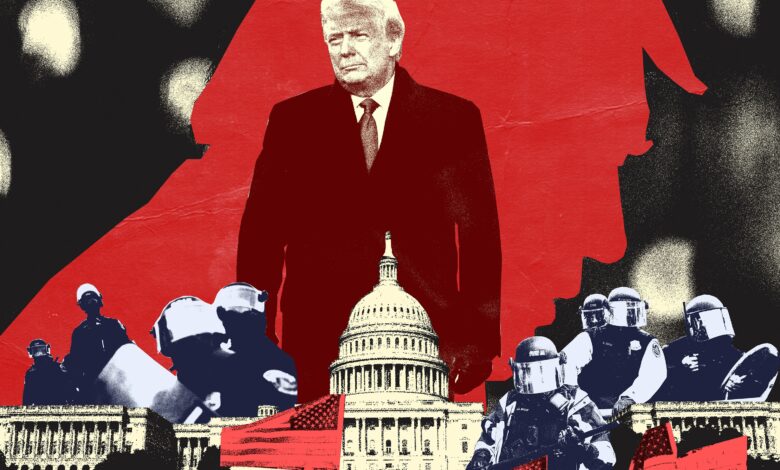“It Was Horrific”: A Situation Room Officer’s Harrowing Account of an American Insurrection

Dawn had not yet broken when Mike Stiegler steered his blue Toyota Camry toward the White House on January 6, 2021. It was 4:20 a.m., and Stiegler was arriving early for his twelve-hour shift as a desk officer in the White House Situation Room.
Normally at this hour, downtown Washington, D.C., was deserted, its monuments and office buildings silent under the black night sky. But when Stiegler stepped out of his car, he sensed something strange. “All these people on the street that you don’t normally see, and a bunch of cars parked,” he told me. “I’ve tried to describe this many times to many people, but it just felt different.”
That afternoon, Congress was scheduled to certify the election of Joe Biden as the forty-sixth president of the United States. But the incumbent he defeated was doing everything he could to block the transfer of power. Thousands of his followers had come to Washington at his request to stop the certification, and no one knew for sure how the day would play out. The Situation Room staff was on alert, monitoring events, synthesizing public information and private intelligence, and preparing to report to the president—as they did with all crises, domestic or foreign, that might require his attention. But on this day, they never called him. He didn’t call them. The president himself was the cause of the crisis.
This doesn’t feel right, Stiegler thought as he began his shift. An intelligence analyst in his thirties, he had been thrilled in the summer of 2019 to get the call to serve in the Situation Room—a plum assignment for any intelligence professional. In the eighteen months since then, “I witnessed two impeachments. I went through Covid. I went through the Black Lives Matter protests and the riots,” he told me. “It was just one thing after another.” Now, as the sun rose, he steeled himself for what might come.
All morning, protestors flocked to the Ellipse, the grassy oval expanse just south of the White House. At noon, President Donald Trump stood in front of his edgy and excited supporters and called on Vice President Mike Pence to send the vote back to the states. He claimed that “radical left Democrats” had stolen the election. He urged the crowd to “fight like hell. And if you don’t fight like hell, you’re not going to have a country anymore.” And then he told them to march down Pennsylvania Avenue to the Capitol.
Trump wanted to join them, but his Secret Service detail refused to take him, because pandemonium had erupted on the Capitol grounds. Protestors stormed police barriers, attacking multiple officers. “We have been flanked, and we’ve lost the line!” shouted D.C. police commander Robert Glover as the mob surged forward, smashing windows and flooding into the building. Secret Service agents hustled Vice President Pence to a secure location, and lawmakers huddled in terror as mobs charged the hallways, breaching the U.S. Senate chamber. Rioters emptied cabinets and upended furniture. Gunshots echoed through the hallowed corridors in the 228-year-old seat of our nation’s legislature.
Back in the Oval Office, President Trump sipped Diet Coke as he watched the spectacle on television. Aides and allies implored him to condemn the riot and call off the mob. Instead, at 2:24, with the violence raging, he sent out a tweet calling out Mike Pence for lacking “the courage to do what should have been done.”
With reports coming in from the Secret Service and other officials on Capitol Hill, the Situation Room scrambled into action. “Things got very chaotic,” Stiegler told me. “We went into a continuity-of-government situation.”
Stop there. Take that phrase in: “continuity-of-government situation.” That bland bit of bureaucratic jargon masks a deadly serious set of policies and actions first ordered by President Eisenhower at the height of the Cold War. “COG” was designed to ensure the government would still function after a disaster such as nuclear war. It involves secret command centers—the Sit Room being a critical one—elaborate chains of command, the relocation of Congress and the replacement of executive branch officials killed in attacks. It had been activated only once before, in the immediate aftermath of the September 11, 2001, terror attacks.
The situation was “surreal,” said Stiegler. But he was wary of disclosing more. “I have to be careful,” he told me. “I have been giving a lot of testimony, and I don’t know where the lines quite are.” I ventured that one of his points of contact must have been the Secret Service. He paused, then said, “That’s fair.” Which meant that he was getting real-time updates directly from the chaos in the Capitol building, as the mobs surged through the halls.
The most harrowing part?
“How close we came to losing the vice president,” he told me. He paused, then looked up at the ceiling, struggling to compose himself. “The screams, the yelling. The different things that we heard that day.” Stiegler is a young man with a cheerful disposition, but when he talked about January 6 he seemed to age before my eyes.
“It was horrific,” he said quietly. “There’s a group of us that were on duty that day, and we don’t know how to process it still…We don’t know how to talk about it. And we don’t know who to talk about it with. There are a lot of things we witnessed that day that we can’t talk about. And how do you deal with that?”
In the six decades since the creation of the Situation Room, it has been the crisis center during America’s catastrophes. The men and women of the Sit Room have dealt with nuclear scares, the assassination of a president and attempts on two others. They stayed at their posts on 9/11, when the White House itself was the target of terrorists. And they tracked and analyzed American wars that cost hundreds of thousands of lives and billions upon billions of dollars. But never before had they dealt with an insurrection against our own government, inspired by the president of the United States.
If the election certification hadn’t gone through, Stiegler told me, “I think we would have possibly seen an institution just crack, crumble. I think a lot of us would have walked out.” These staffers serve the per-son who lives in the White House, but they work for the presidency, not the president. “Your allegiance to your country supersedes your allegiance to your role,” said Stiegler. Those dueling loyalties had never been tested like this.
By the time mobs stormed the Capitol on January 6, Mike Stiegler had been serving in the Situation Room for a year and a half. It had been an exhausting time, and Stiegler was nearing the end of his emotional rope.
He’d arrived for work at the White House at 4:20 a.m. on January 6, and for the next twelve hours he endured the insanity of seeing a sitting president encourage a coup, wondering if the vice president would survive the day, and unsure whether America’s 245-year-old democratic experiment was crashing to an end.
“It was so surreal,” he says, “in the sense that you had utter chaos happening at the Capitol, and we had just witnessed all of this craziness. And you walked out of the White House grounds and nothing was happening. It was empty. There’s nobody on the streets, because all of them were blocked off at that point…It was literally a ghost town.”
The handful of Sit Room staffers who’d just finished their shifts walked slowly to their cars. “We just stood there for a few minutes,” Stiegler recalls. “It’s like when you mix cold water with hot water, you have to take a second for it to meld together to one temperature. We had to take a minute to feel, Okay, all right. Get in the car. Keep moving. Let’s get out of here.”
I asked Stiegler what he said to his wife when he got home. “I don’t, I don’t think…” he said, then had to stop. “Now you’re getting me all teary.” He took a breath. “I don’t think we even really said anything…I still don’t know how to talk about half of it.” He recalls that his wife asked if he wanted to watch the news. “I said, ‘No, don’t turn it on. I can’t right now. I can’t do it.’ And I had to go back the next day.”
That’s right: At five a.m. on January 7, Stiegler was back in the Sit Room. What was it like going back in to work?
“Peaceful chaos,” he told me. “You’re driving by tanks and it’s utterly surreal…They had to sniff your car for bombs and look underneath, and you had to be cleared and swiped for different weapons. And then you got a sticker they would put on your windshield to say that you’re cleared to drive around D.C. And you’re just like, ‘Dude, I’m just trying to go to work. This is unbelievable.’”
This was a dream job for Stiegler. From his earliest days as an intelligence analyst, he told me, working in the White House was on his “bucket list.” He even wrote his master’s thesis on the inner workings of the Situation Room. On the good days, the job lived up to the hype.
“The best part was, you have complete access to the White House,” he told me, smiling at the memory. “When I was on night shifts alone, I would walk around those hallways and look at the different rooms. And sometimes in the early mornings, I would take a cup of coffee and go sit in the Rose Garden, or ask the Secret Service to open up the Oval and just stand there for a minute. I mean, it’s magic. It doesn’t get better than that.”
In addition to those special moments, he said, “there’s nothing that parallels being able to pick up the phone and call anyone and get information. The authority that the White House Situation Room carries is just incredible. You’re never going to have that pull ever again.”
And the worst part?
“I’ll say it as politically correctly as I can,” he began. “I really struggled sometimes ethically, working and witnessing some of the stuff I was witnessing and then walking outside that gate at Lafayette [Park] and wanting to be on the other side of that fence.” Meaning, anywhere but working in the White House.
The Black Lives Matter protests in the summer of 2020 hit particularly hard. “I was witness to many conversations and comments about what was going on,” he told me. “It was difficult to be associated with [the Trump White House] and walk out, and we would get death threats thrown at us. We would get insults. As soon as you walk outside that gate, you’re associated with that administration.
“I would leave sometimes and literally be escorted by either National Guard or Secret Service to my car,” he went on. “And then I would just sit in my car and either have to call a friend or just sit there for ten minutes and just decompress for a moment and kind of disassociate myself. No, I’m serving my country. I’m serving the office of the president. Even if I don’t agree with certain things. I [tried] to disassociate that, but I wasn’t always successful.”
In the two weeks between January 6 and the January 20 inauguration, downtown Washington, D.C., looked like a war zone, with armed patrols, hastily erected fences, and a general air of dread hovering over the capital. “Everybody was deathly afraid of something happening,” Stiegler recalls. “Even around the White House…they had charter buses literally touching, making a complete wall around.” When he was scheduled to work inauguration night, Stiegler knew it would take forever to get through all the roadblocks and security, so he left home at 1:00 p.m. to make his 5:00 p.m. shift. He got there in time, thanks to a surprise assist from the Secret Service.
“I made it through some of the checkpoints and I was at the final [one],” he recalls. The Secret Service stopped him to ask where he was going. He showed his White House badge and said he was heading to the Situation Room. “They’re like, ‘Well, the VP [incoming vice presi-dent Kamala Harris] is about to go from the Lincoln Memorial to the White House for the first time…When the convoy goes by, just join it.’” Stiegler smiles at the memory. “If there’s any footage of the VP going down Constitution to go to the White House for the first time, there’ll be a blue Camry hybrid in the back of the convoy, and then me peeling off to go to work.”
Stiegler parked in his usual spot, then hustled over to watch Vice President Harris’s arrival. There were “bands playing and people clap-ping,” he says. “It was just jovial. It was different.” How did he feel at that point? “It was a sigh of relief. It was a feeling of, not to be cliché, but a little bit of hope. Like, we made it. Maybe this will be different.”
Yet Stiegler is quick to clarify: “Not different in the sense of politically, or political priorities,” he told me. “But like, maybe we can just be normal for a minute? Maybe we can just stabilize for a
bit.” Sit Room officers are the most rigorously apolitical people in the White House, a distinction Stiegler took seriously, no matter what his personal feelings were about the changing of administrations.
“In my role as desk officer, I was chosen that night to write President Biden’s first overnight briefing,” he says. “But it didn’t change anything. I don’t care if I’m writing for President Trump or President Biden, I still gave it a hundred percent…It was an honor, it was great, but at that point it was pretty routine.” For Stiegler and his fellow Sit Room staffers, it was back to work, as usual. “Like, okay, pause, bless the moment. Appreciate the moment,” he says. “But then close that off and get back to work.”
I told Stiegler that I might have been tempted to add a little hand-written note to the briefing, wishing the new president good luck.
“God, I would have loved to,” he said. “But no, we are apolitical. We serve in silence.”
At the end of our interview, I asked Stiegler if he felt any bitterness about the difficult experience he had in the Situation Room.
“I would probably feel bitter if I didn’t have the colleagues that I had,” he told me. “We just formed our own family and our own defenses. But I think, if I were to apply ‘bitter’ to anything, it’s bitter that I didn’t get the traditional experience, you know? But in the same regard, once this all settles, maybe ten years from now, I’ve got some hell of a story to tell my grandkids, right?”
He laughed, then added ruefully, “I wanted to be in the middle of history. Be careful what you wish for.”
Excerpted from THE SITUATION ROOM: The Inside Story of Presidents in Crisis © 2024 George Stephanopoulos with Lisa Dickey and reprinted by permission from Grand Central Publishing/Hachette Book Group.
-
Cover Star Chris Hemsworth on Fear, Love, and Escaping Hollywood
-
The Vatican’s Secret Role in the Science of IVF


